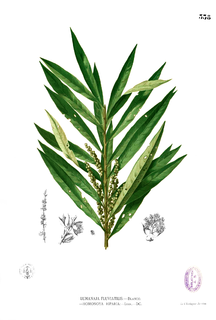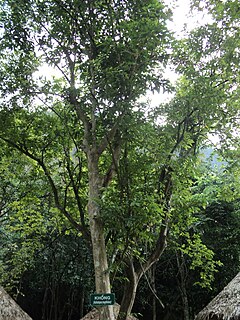Related Research Articles

Antidesma is a genus of tropical plant in the family Phyllanthaceae formally described by Linnaeus in 1753. It is native to tropical Africa, S + E + SE Asia, Australia, and various oceanic islands. The greatest diversity occurs in Southeast Asia.

Mallotus is a genus of the spurge family Euphorbiaceae first described as a genus in 1790. Two species are found in tropical Africa and Madagascar. All the other species are found in East Asia, the Indian Subcontinent, Southeast Asia, eastern Australia, and certain islands of the western Pacific. The genus has about 150 species of dioecious trees or shrubs.
Trigonostemon is a plant genus of the family Euphorbiaceae and the sole member of its tribe (Trigonostemoneae). It was first described as a genus in 1826. It is native to Southeast Asia, southern China, the Indian Subcontinent, Queensland, and a few islands in the western Pacific.
Wetria is a plant genus of the family Euphorbiaceae, first described as a genus in 1858. It is native to Australia, New Guinea and Southeast Asia.
- Wetria australiensisP.I.Forst. - Papua New Guinea, Queensland
- Wetria insignis(Steud.) Airy Shaw - Thailand, Myanmar, Peninsular Malaysia, Borneo, Sumatra, Java, Lesser Sunda Islands, Philippines

Homonoia is a plant genus of the family Euphorbiaceae first described in 1790. These are rheophytes and usually found in groups at riverbanks in India, southern China, Southeast Asia, and New Guinea.
- Homonoia intermediaHaines - India
- Homonoia retusa Müll.Arg. - India
- Homonoia riparia Lour. - Guangxi, Guizhou, Hainan, Sichuan, Taiwan, Yunnan, Cambodia, India, Assam, Bhutan, Sri Lanka, Borneo, Java, Lesser Sunda Islands, Sulawesi, Sumatra, Maluku, Laos, Malaysia, Myanmar, Philippines, Thailand, Vietnam, New Guinea, Andaman & Nicobar Islands

Agrostistachys is a plant genus of the family Euphorbiaceae first described as a genus in 1850. It is native to Southeast Asia, New Guinea, India, and Sri Lanka.
- Agrostistachys borneensisBecc. - India, Sri Lanka, Thailand, Vietnam, Malaysia, Borneo, Philippines, Sumatra, New Guinea
- Agrostistachys gaudichaudiiMüll.Arg. - Thailand, Peninsular Malaysia
- Agrostistachys hookeri(Thwaites) Benth. & Hook.f. - Sri Lanka
- Agrostistachys indicaDalzell - India, Sri Lanka, Thailand, Vietnam, Myanmar, Laos, Cambodia, Malaysia, Borneo, Philippines, New Guinea
- Agrostistachys sessilifolia(Kurz) Pax & K.Hoffm. - Peninsular Malaysia, Borneo, Sumatra
- Agrostistachys staminodiataSevilla - Sumatra

Koilodepas is a genus of plant of the family Euphorbiaceae first described as a genus in 1856. It is native to Southeast Asia, India, Hainan, and New Guinea.
Syndyophyllum is a plant genus of the family Euphorbiaceae, first described as a genus in 1900. It is native to Sumatra, Borneo, and New Guinea.
- Syndyophyllum excelsum K.Schum. & Lauterb. - New Guinea
- Syndyophyllum occidentale Welzen - Sumatra, Borneo
Blumeodendron is a genus of dioecious trees of the family Euphorbiaceae first described as a genus in 1873. It is widespread across much of Southeast Asia and Papuasia.
Botryophora is a genus of plant of the family Euphorbiaceae first described as a genus in 1888. It contains only one known species, Botryophora geniculata, native to Thailand, Myanmar, Malaysia, Borneo, Sumatra, and Java.
Ptychopyxis is a genus of plant of the family Euphorbiaceae first described in 1861. It is native to Southeast Asia and New Guinea.
- Ptychopyxis arborea - Borneo
- Ptychopyxis bacciformis - Vietnam, Borneo, Sumatra, Philippines, W Malaysia
- Ptychopyxis caput-medusae - W Malaysia
- Ptychopyxis chrysantha - New Guinea
- Ptychopyxis costata - Borneo, Sumatra, W Malaysia
- Ptychopyxis glochidiifolia - Sumatra, Sarawak, Brunei, Kalimantan Timur
- Ptychopyxis grandis - Borneo
- Ptychopyxis javanica - S Thailand, Vietnam, W Malaysia, Borneo, Sumatra, Java
- Ptychopyxis kingii - W Malaysia, E Sumatra, Sarawak, Sabah
- Ptychopyxis plagiocarpa - S Thailand, S Myanmar

Endospermum is a genus of plants, under the family Euphorbiaceae and the monotypic subtribe Endosperminae first described as a genus in 1861 It is native to E + S + SE Asia, Papuasia, Queensland, and certain islands of the W Pacific.

Dimorphocalyx is a genus of plants under the family Euphorbiaceae first described as a genus in 1861. It is native to Southeast Asia, Hainan, India, Sri Lanka, New Guinea, and Queensland.

Aporosa is a genus of flowering plant belonging to the family Phyllanthaceae first described as a genus in 1825. It is native to China, the Indian Subcontinent, Southeast Asia, Papuasia, and Queensland.

Cleistanthus is a plant genus of the family Phyllanthaceae, tribe Bridelieae, first described as a genus in 1848. It is widespread in much of the Old World Tropics in Asia, Africa, Australia, and various oceanic islands. Cleistanthus collinus is known for being toxic and may be the agent of homicides or suicides.

Breynia is a plant genus in the family Phyllanthaceae, first described in 1776. It is native to Southeast Asia, China, the Indian Subcontinent, Papuasia, Australia, and the island of Réunion.

Scindapsus is a genus of flowering plants in the family Araceae. It is native to Southeast Asia, New Guinea, Queensland, and a few western Pacific islands. The species Scindapsus pictus is common in cultivation.

Pholidota, commonly known as rattlesnake orchids, is a genus of flowering plants from the orchid family, Orchidaceae. Plants in this genus are clump-forming epiphytes or lithophytes with pseudobulbs, each with a single large leaf and a large number of small, whitish flowers arranged in two ranks along a thin, wiry flowering stem that emerges from the top of the pseudobulb. There are about thirty five species native to areas from tropical and subtropical Asia to the southwestern Pacific.

Thelasis, commonly known as fly orchids, is a genus of flowering plants from the orchid family, Orchidaceae. Plants in this genus are usually epiphytes, sometimes lithophytes or rarely terrestrials. Some species have pseudobulbs with up to three leaves, whilst others have several leaves in two ranks. A large number of small, white or greenish yellow flowers are borne on a thin, arching flowering stem. There are about thirty species, distributed from tropical and subtropical Asia to the southwest Pacific.
Chilocarpus is a genus of plant in the family Apocynaceae, first described as a genus in 1823. The genus is native to India, Southeast Asia, and New Guinea.
- Chilocarpus beccarianusPierre - Borneo
- Chilocarpus conspicuus(Steenis) Markgr. - Borneo
- Chilocarpus costatusMiq. - Borneo, Sumatra, W Malaysia, Thailand, Myanmar
- Chilocarpus decipiensHook.f. - Sumatra, W Malaysia
- Chilocarpus denudatusBlume - S India, Nicobar Islands, Indochina, Malaysia, Indonesia, New Guinea
- Chilocarpus hirtusD.J.Middleton - Borneo, Sumatra
- Chilocarpus obtusifoliusMerr. - Borneo, Sumatra, W Malaysia
- Chilocarpus pubescensD.J.Middleton - Borneo
- Chilocarpus rostratusMarkgr. - Borneo, Sumatra, W Malaysia, Thailand
- Chilocarpus sarawakensisD.J.Middleton - Sarawak
- Chilocarpus steenisianusMarkgr. - Borneo
- Chilocarpus suaveolensBlume - Borneo, Sumatra, Java
- Chilocarpus torulosus(Boerl.) Markgr. - Borneo
- Chilocarpus vernicosusBlume - Borneo, Sumatra, W Malaysia
References
- 1 2 3 Kew World Checklist of Selected Plant Families
- ↑ Pax, Ferdinand Albin. 1897. in Engler, Heinrich Gustav Adolf & Prantl, Karl Anton Eugen, Die Natürlichen Pflanzenfamilien Nachter. 1: 213
- ↑ Tropicos
- ↑ Govaerts, R., Frodin, D.G. & Radcliffe-Smith, A. (2000). World Checklist and Bibliography of Euphorbiaceae (and Pandaceae) 1-4: 1-1622. The Board of Trustees of the Royal Botanic Gardens, Kew.